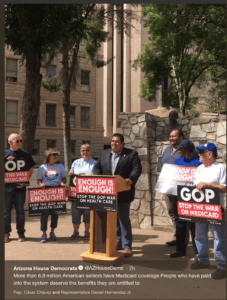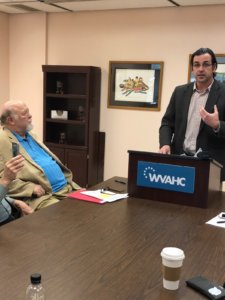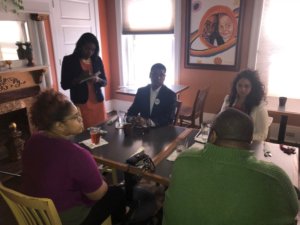Throughout the third week of Medicaid Awareness Month, advocates across the country highlighted the significant role Medicaid plays supporting seniors and older adults, and spoke out against Republican proposals to weaken and cut Medicaid. Medicaid covers more than 15 million Americans over age 50.

In Arizona, the the Arizona Alliance for Retired Americans and Arizona Alliance for Healthcare Security joined state Reps. Daniel Hernandez and Cesar Chavez to discuss how Medicaid serves a lifeline to Arizona’s Seniors and older Americans.
How does Medicaid help seniors and older adults in the United States? Here are some of the many ways:
- More Than 6.9 Million American Seniors Have Medicaid Coverage. 6,920,200 seniors, age 65 and older, are enrolled in Medicaid.
- More Than 8.5 Million Adults Ages 50 To 64 Are Enrolled In Medicaid. More than 8.5 million Americans ages 50 to 64 have health coverage through Medicaid – many thanks to the Affordable Care Act’s Medicaid expansion.
- Nearly 1 In 3 Seniors Live Below 200 Percent Of The Federal Poverty Line. For many of these seniors, Medicaid is a critical lifeline.
- Medicaid Funds 53 Percent Of Long-Term Care Nationwide. As seniors age, long-term care services become more and more vital, serving half of seniors over age 75 and three in four seniors over age 85.
- Medicaid Covers 6 In 10 Nursing Home Residents. The average annual cost of nursing home care is $82,000 – nearly three times most seniors’ annual income.
- Over 1 In 5 Medicare Beneficiaries Also Have Medicaid Coverage. Most dual-eligibles are over age 65, and are more likely to have complex and chronic health needs.

In West Virginia, West Virginians Together for Medicaid, West Virginians for Affordable Health Care, West Virginia Citizen Action Group, and the West Virginia Center on Budget and Policy joined together to discuss the importance of Medicaid for seniors in the state and how cuts to the program be devastating for older West Virginians.
In the Daily Post-Athenian, Pam Weston of Sweetwater, Tennessee highlighted the benefits Medicaid provides for Tennessee residents:
In Tennessee alone, Medicaid provides coverage for 1,539,743 of our citizens, a number which includes children, senior citizens, and persons with severe disabilities. If Tennessee had implemented Medicaid expansion, the number eligible for coverage would have easily surpassed 2 million.
What many may not realize is that Medicaid provides $4 billion annually to support school-based health services. Sixty-eight percent of Tennessee’s schools use Medicaid funds to provide school nurses, counselors, and speech therapy. Outside the school setting, Medicaid covers 43 percent of all Tennessee’s children.
At a time when the opioid epidemic is a concern for most of Tennessee, it is important to note that 10 percent of all buprenorphine used to treat opioid addiction is paid for by Medicaid dollars.
Lastly, three out of five nursing home residents rely on Medicaid to cover their healthcare needs, and nearly a quarter of all seniors and individuals with disabilities are covered by Medicaid.
If $1.4 trillion is to be cut from Medicaid to offset the tax breaks provided to cororations under the recent “tax reform” plan, should the cuts be applied to medically fragile seniors, children, or to those with disabilities? It is said that a nation is judged by how it cares for it’s most vulnerable citizens. Cuts and per capita caps applied to Medicaid services will leave our most vulnerable without the care they require, and that does not speak well for what we have become.

In Tennessee, six Nashville residents, including small business owners, non-profit directors, and reverends, shared their personal stories of how Medicaid has benefitted their mother, fathers, and grandparents and grandparents.
Lindsey Copeland highlighted the work of Medicaid Awareness Month for the Medicare Rights Center.
And in The Hill, Max Ritchman, president and CEO of the National Committee to Preserve Social Security and Medicare, highlighted how just how important Medicaid is for older Americans’ health. Read his post:
April is Medicaid Awareness Month, but many Americans are truly unaware of what the program does for seniors. Medicaid is typically viewed as a health insurance program for the poor, which, of course, it is. But it also provides crucial supports for older Americans. Medicaid covers nearly 7 million seniors and more than 8.5 million “near seniors” aged 50-64. One in five Medicare beneficiaries (known as “dual eligibles”) also have Medicaid coverage to help pay premiums and co-pays.
Many people don’t realize that Medicaid helps millions of seniors to pay for long-term care — in skilled nursing facilities as well as in-home and community-based care. In fact, Medicaid pays for more than 50 percent of long-term care nationwide. The program covers 6 in 10 nursing home residents. At an average annual cost of $82,000 (nearly three times most seniors’ annual incomes) long-term care would simply be out of reach for millions of elderly Americans if it weren’t for Medicaid.
“Seniors often need services from Medicaid that are not covered by Medicare,” says Rebecca Vallas, VP of the Poverty Program at the Center for American Progress. “These services include assistance with bathing and dressing, preparing meals, and many other activities of daily living.” Vallas explains that Medicaid “allows millions of seniors to age in place, to stay with their families and in their communities.”
In a Facebook Live interview this week, Rep. Joe Kennedy III (D-Mass.) told me that Medicaid is “the backbone for our healthcare infrastructure across the country.” But the Congressman isn’t confident that Americans sufficiently appreciate the crucial role that Medicaid plays. “So many [people] have heard of these programs,” said Rep. Kennedy, “But they don’t quite understand how integral they have become to preserving the dignity, the stability, the security of so many Americans.”
President Lyndon Johnson signed Medicaid and Medicare into law in 1965, and it’s no accident that the two were created simultaneously. Both programs were designed to provide health insurance to vulnerable members of society who previously went without medical coverage — including the poor and the elderly. Over the past half a century, Medicare and Medicaid have been expanded to cover more people and more services.
Medicaid’s ability to cover older Americans at a time of their lives when chronic conditions and other health issues typically emerge took a big leap forward with passage of the Affordable Care Act (ACA). The ACA expanded Medicaid to cover people earning up to 138 percent of the poverty line. As a result, more than 15 million additional Americans received federal health coverage.
Many of those were in the 50-64 age group that typically has trouble buying private health insurance. According to the Center for Retirement Research, “The share of Americans ages 50-64 without insurance fell by 6.4 percentage points between 2012 and 2016 — due at least in part to increased Medicaid enrollment in the expansion states.”
Unfortunately, Medicaid has been under siege in Congress ever since the ACA was enacted. When the majority party took control of all branches of government in 2017, they tried relentlessly to gut the program — starting with Obamacare repeal legislation all the way through President Trump’s first two budgets and various House GOP budget proposals.
The details vary in each dark scenario, but the commonalities included cutting more than $1 trillion from Medicaid, imposing per capita caps on payments to the states, or converting it into a block grant program. The Congressional Budget Office (CBO) estimated that these draconian measures would have resulted in 14 million Americans losing health coverage over the next ten years.
Even though those devastating proposals failed, Medicaid remains under assault from the right. The Trump/GOP tax cuts enacted last December will blow a $1.5 trillion hole in the national debt, inviting deep cuts to Medicaid (as well as Medicare and Social Security). Meanwhile, according to Americans for Tax Fairness, when the new tax law is fully phased in, 83 percent of the tax cuts will go to the wealthiest 1 percent.
Unsatisfied with the mere prospect of slashing Medicaid, the majority party offered a Balanced Budget Amendment (BBA) last week that would have triggered $114 billion in Medicaid cuts in a single year. The BBA attracted 233 votes (mostly along party lines), but fortunately failed to win the 2/3 of the House it would have needed to advance to the Senate.
The onslaught continues in the Trump administration, which is busy granting waivers for work requirements, drug testing, and other bureaucratic barriers that will result in Medicaid patients being kicked off the rolls.
“President Trump and his colleagues in Congress appear to have learned from their failed attempt to take away health insurance from tens of millions legislatively… that they need to do it in a back-door way, without the public catching on,” says Vallas.
Ironically, the right’s efforts to destroy the ACA and gut Medicaid have made Americans more aware of the program’s value. “They did something that Democrats couldn’t do for a long time. They made Medicaid popular,” says Rep. Kennedy.
Indeed, a Kaiser Health Tracking Poll conducted in March found that 74 percent of Americans have a positive opinion of Medicaid, including 65 percent of Republicans. In that same poll, 7 in 10 respondents said that they have a personal connection to Medicaid — either because of their own medical coverage or their child’s, or indirectly through a family member or friend.
In a recent poll by the Center for American Progress, a whopping 80 percent of respondents (across party lines) said they oppose cutting Medicaid. “The Trump agenda of dismantling health care is the opposite of what the American people want,” says Vallas. “Americans want their policymakers to ensure that everyone has access to healthcare, not take away programs like Medicaid that make it possible for grandma to be in the nursing home.”
Our elected leaders need to understand that these Americans whose lives have been touched by Medicaid — or likely will be by the time they are older — are people for whom Medicaid is a lifeline. They are not figures on a ledger, despite budget hawks’ tendency to view them that way. Even if our leadership isn’t sufficiently aware, it’s important that all of us — their constituents — understand the myriad benefits that Medicaid provides seniors and everyone else who truly needs them. In fact, let’s make every month “Medicaid Awareness Month” until the program is safe from attack by budget slashers and properly fortified for the future.

